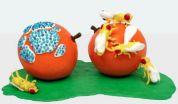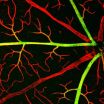(Press-News.org)
VIDEO:
The ability to detect rotten food is so crucial for survival that even flies have a dedicated neural circuit to do just that, according to a study published on December...
Click here for more information.
The ability to detect rotten food is so crucial for survival that even flies have a dedicated neural circuit to do just that, according to a study published on December 6th in the Cell Press journal Cell. The brain circuit allows flies to avoid feeding and laying eggs on fruit covered in toxic molds and bacteria and represents a unique, specialized system for detecting a repulsive odor.
"When this compound is present in the air, even the most attractive food source becomes unattractive," says senior study author Bill Hansson of the Max Planck Institute for Chemical Ecology. "This is highly interesting, as it's seldom that single compounds have a direct behavioral effect and that they are active at extremely low concentrations as we observe here."
The vinegar fly (Drosophila melanogaster) feeds on yeast that grows on fermenting fruit, and the olfactory pathways that underlie the insect's attraction toward the smell of vinegar have been well characterized. But relatively little is known about circuits that mediate avoidance of foul odors. One potential candidate for a dedicated avoidance circuit was recently discovered by Hansson and his collaborators, who found that the chemical geosmin, which is produced by harmful fungi and bacteria, is strongly repulsive to flies.
In the new study, the researchers identified a specialized neural circuit that is highly sensitive to low concentrations of geosmin and responds exclusively to this earthy odor. Activation of this circuit was necessary for the ability of flies to avoid feeding or laying eggs on substances emitting geosmin and was sufficient to repulse flies from the alluring scent of fruit. Moreover, the geosmin detection system was found across species in the genus Drosophila, suggesting that the circuit evolved to enable avoidance of toxic feeding and breeding sites in the environment.
"It is obviously highly important for all organisms to stay away from spoiled food," says lead study author Marcus Stensmyr of the Max Planck Institute for Chemical Ecology. "Detecting and avoiding food infested by bad microbes seems to be a ubiquitous phenomenon, where the nervous system has evolved to extreme degrees to make it work."
INFORMATION:
Stensmyr et al.: "A conserved dedicated olfactory circuit for detecting harmful microbes in Drosophila."
Disgust circuit: Flies sniff out and avoid spoiled food
2012-12-06
ELSE PRESS RELEASES FROM THIS DATE:
Mexican paradox: While opinion surveys overestimate abortions 10-fold, abortion mortality clearly decreases
2012-12-06
This press release is available in Spanish and French. A collaborative study conducted in Mexico by researchers from the West Virginia University-Charleston (US), Universidad Popular Autónoma del Estado de Puebla (México), Universidad de Chile and the Institute of Molecular Epidemiology of the Universidad Católica de la Santísima Concepción (Chile), revealed that opinion surveys used by researchers from the Guttmacher Institute overestimated figures of induced abortion in the Federal District of Mexico (Mexico DF) up to 10-fold. The research recently published in the International ...
A direct line through the brain to avoid rotten food -- a full STOP signal for Drosophila
2012-12-06
VIDEO:
Bill Hansson and Marcus Stensmyr explain their results now published in CELL.
Click here for more information.
Consuming putrid food can be lethal as it allows bacterial pathogens to enter the digestive system. To detect signs of decay and thus allowing us and other animals to avoid such food poisoning is one of the main tasks of the sense of smell. Behavioral scientists and neurobiologists at the Max Planck Institute for Chemical Ecology in Jena, Germany, have ...
Scientists identify molecules in the ear that convert sound into brain signals
2012-12-06
LA JOLLA, CA – December 6, 2012 – For scientists who study the genetics of hearing and deafness, finding the exact genetic machinery in the inner ear that responds to sound waves and converts them into electrical impulses, the language of the brain, has been something of a holy grail.
Now this quest has come to fruition. Scientists at The Scripps Research Institute (TSRI) in La Jolla, CA, have identified a critical component of this ear-to-brain conversion—a protein called TMHS. This protein is a component of the so-called mechanotransduction channels in the ear, which ...
Flexible silicon solar-cell fabrics may soon become possible
2012-12-06
For the first time, a silicon-based optical fiber with solar-cell capabilities has been developed that has been shown to be scalable to many meters in length. The research opens the door to the possibility of weaving together solar-cell silicon wires to create flexible, curved, or twisted solar fabrics. The findings by an international team of chemists, physicists, and engineers, led by John Badding, a professor of chemistry at Penn State University, will be posted by the journal Advanced Materials in an early online edition on 6 December 2012 and will be published on a ...
Hubble sees a galaxy hit a bullseye
2012-12-06
In Hubble's image, NGC 922 clearly reveals itself not to be a normal spiral galaxy. The spiral arms are disrupted, a stream of stars extends out towards the top of the image, and a bright ring of nebulae encircles the core. Observing with NASA's Chandra X-ray Observatory reveals more chaos in the form of ultraluminous X-ray sources dotted around the galaxy.
NGC 922's current unusual form is a result of a cosmic bullseye millions of years ago. A smaller galaxy, catalogued as 2MASXI J0224301-244443, plunged right through the heart of NGC 922 and shot out the other side. ...
Biochemists trap a chaperone machine in action
2012-12-06
AMHERST, Mass. – Molecular chaperones have emerged as exciting new potential drug targets, because scientists want to learn how to stop cancer cells, for example, from using chaperones to enable their uncontrolled growth. Now a team of biochemists at the University of Massachusetts Amherst led by Lila Gierasch have deciphered key steps in the mechanism of the Hsp70 molecular machine by "trapping" this chaperone in action, providing a dynamic snapshot of its mechanism.
She and colleagues describe this work in the current issue of Cell. Gierasch's research on Hsp70 chaperones ...
Image of the Carina Nebula marks inauguration of VLT Survey Telescope
2012-12-06
The latest telescope at ESO's Paranal Observatory in Chile -- the VLT Survey Telescope (VST) -- was inaugurated today at the Italian National Institute for Astrophysics (INAF) Observatory of Capodimonte, in Naples, Italy. The ceremony was attended by the Mayor of Naples, Luigi De Magistris, the INAF President, Giovanni Bignami, the ESO representatives Bruno Leibundgut and Roberto Tamai, and the main promoter of the telescope, Massimo Capaccioli of the University of Naples Federico II and INAF.
The VST is a state-of-the-art 2.6-metre telescope, with the huge 268-megapixel ...
Research on blood vessel proteins holds promise for controlling 'blood-brain barrier'
2012-12-06
Working with mice, Johns Hopkins researchers have shed light on the activity of a protein pair found in cells that form the walls of blood vessels in the brain and retina, experiments that could lead to therapeutic control of the blood-brain barrier and of blood vessel growth in the eye.
Their work reveals a dual role for the protein pair, called Norrin/Frizzled-4, in managing the blood vessel network that serves the brain and retina. The first job of the protein pair's signaling is to form the network's proper 3-D architecture in the retina during fetal development. ...
Immune system kill switch could be target for chemotherapy and infection recovery
2012-12-06
Researchers have discovered an immune system 'kill switch' that destroys blood stem cells when the body is under severe stress, such as that induced by chemotherapy and systemic infections.
The discovery could have implications for protecting the blood system during chemotherapy or in diseases associated with overwhelming infection, such as sepsis.
The kill switch is triggered when internal immune cell signals that protect the body from infection go haywire. Dr Seth Masters, Dr Motti Gerlic, Dr Benjamin Kile and Dr Ben Croker from the Walter and Eliza Hall Institute ...
Nobody's perfect
2012-12-06
Researchers at Cambridge and Cardiff have found that, on average, a normal healthy person carries approximately 400 potentially damaging DNA variants and two variants known to be associated directly with disease traits. They showed that one in ten people studied is expected to develop a genetic disease as a consequence of carrying these variants.
It has been known for decades that all people carry some damaging genetic variants that appear to cause little or no ill effect. But this is the first time that researchers have been able to quantify how many such variants each ...






